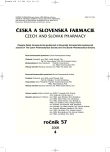Monitoring of pharmacotherapy in seniors of rest homes in Brno region
Authors:
L. Bartošíková 1; J. Nečas 1; T. Bartošík 2; J. Fráňová 3
Authors‘ workplace:
Univerzita Palackého v Olomouci, Lékařská fakulta, Ústav fyziologie
1; Fakultní nemocnice U sv. Anny v Brně, Anesteziologicko-resuscitační klinika
2; Fakultní nemocnice Brno, Dětská nemocnice, II. dětská klinika
3
Published in:
Čes. slov. Farm., 2008; 57, 181-186
Category:
Excerpt
Overview
Polypharmacy is a problem of growing importance in today’s medicine. It has many negative impacts on the patient and healthcare system alike. Seniors with multiple co-morbidities are more likely to be on multiple medications, and therefore they are at higher risk of developing serious side effects or interactions. The aim of the study was to monitor pharmacotherapy of seniors in the rest homes in the Brno region. The study included 72 patients, 26 men and 46 women, of the average age of 84.9 years. Polypharmacy was detected in 92% cases. The number of the most widely prescribed drugs which were medicated in 10 or more patients is 13. Drug interactions are risk of pharmacotherapy but it is possible to avoid them by reduction of polypharmacy.
Key words:
polypharmacy – seniors – drug interactions
Sources
1. Endoh, M.: Cardiovasc. Drug. Ther., 2001; 15, 379–403.
2. Flesch, M., Erdmann, E.: Cardiovasc. Drug. Rev., 2001; 15, 379–386.
3. Cheb, P. D., Bhatt, D. I., Topol, E. J., Oral, G. P.: Cardiovasc. Drug., 2001; 6, 421-428.
4. Plevová, J., Boleloucký, Z.: Psychofarmakoterapie vyššího věku, 2. vyd. Praha, Grada Publishing, 2000, s. 164.
5. Topinková, E.: Geriatrie pro praxi, 1. vyd. Praha, Galén, 2005, s. 270.
6. Motlová, L., Holub, D.: Remedia, 2005; 6, 514–516.
7. Záboj, Z.: Prakt. Lék., 2000; 2, 99–101.
8. Novotný, T.: Medical Tribune, 2005; 16, 9.
9. Strojil, J., Horák, F., Arge, J.: Klin. Farmakol. farm., 2007; 1, 43–45.
10. Alušík, Š.: Vnitř. Lék., 1999; 5, 315–318.
11. Gruberová, B.: Gerontologie, 1. vyd. České Budějovice, Jihočeská univerzita, Zdravotně sociální fakulta, 1998, s. 86.
13. Kriška, M. et al.: Memorix klinickej farmakologie, 1. vyd. Bratislava, Slovac Academic Press, 2002, s. 897.
14. Kriška, M. et al.: Riziko liekov v medicínskéj praxi. 1. vyd. Bratislava, Slovak Academic Press, 2000, s. 474.
15. Hegyi, L.: Geriatria, 2005; 2, 78–82.
16. Křivohlavý, J.: Prakt. Lék., 2000; 5, 272–275.
17. Katzung. B. G.: Základní a klinická farmakologie, 2. vyd. Praha, Nakladatelství a vydavatelství H & H, 1995, s. 1072.
18. Bertilsson, L., Dahl, M. L., Dalen, P., Al-Shurbaji, A.: Brit. J. Clin. Pharmacol., 2002; 53, 111–122.
19. Bultas, J., Doležal, T.: Remedia, 2001; 2, 157–161.
20. Michalets, E. I.: Pharmacotherapy, 1998; 1, 84–112.
21. Fialová, D., Topinková, E.: Remedia, 2005; 4–5, 410–417.
22. Topinková, E., Fialová, D.: Postgrad. Med., 2002; 4, 477–482.
23. Baštecký, J. et al.: Gerontopsychiatrie, 1. vyd. Praha, Grada Avicenum, 1994, s. 320.
24. Gates, J. D.: Long term network: EDA 313-0198, 2000.
Labels
Pharmacy Clinical pharmacologyArticle was published in
Czech and Slovak Pharmacy

2008 Issue 4
Most read in this issue
- Actual acidity of the environment and efficacy of auxiliary substances used for antimicrobial stabilization of medicinal preparations prepared in pharmacies
- Monitoring of pharmacotherapy in seniors of rest homes in Brno region
- Antiradical activity of substances with a potential effect on the cardiovascular system
- A study of the properties of tablets from two types of directly compressible xylitol
